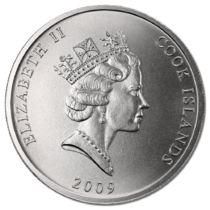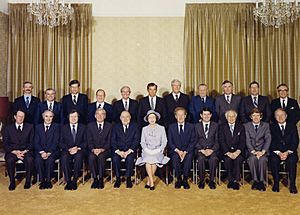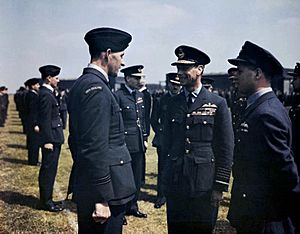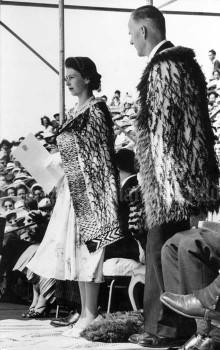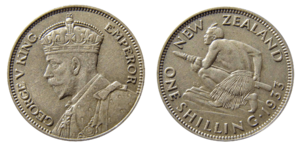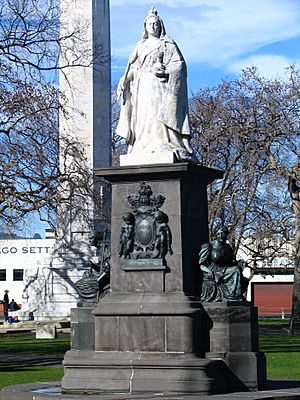Monarchy of New Zealand facts for kids
The monarchy of New Zealand is New Zealand's system of government where a King or Queen is the head of state. This means the role of head of state is passed down through a family. The current monarch is King Charles III, who became King on 8 September 2022.
The Treaty of Waitangi was signed between Queen Victoria and Māori chiefs (rangatira) on 6 February 1840. This important agreement led to British rule over New Zealand on 21 May 1840. From then on, the British monarch became New Zealand's head of state. Over time, New Zealand became more independent from Britain. The monarchy in New Zealand also changed to become a unique part of New Zealand's identity, with its own special symbols.
The King of New Zealand is also the monarch for 14 other countries in the Commonwealth of Nations. In each of these countries, the monarchy is legally separate. So, King Charles III is officially called King of New Zealand (Māori: Kīngi o Aotearoa). He and other members of the royal family visit New Zealand and do public and private duties. However, only the King has a role in the country's laws and government.
The King holds all the main power in New Zealand. His approval is needed for parliament to make laws and for other official decisions to take effect. But in reality, the King's power is limited by New Zealand's constitutional monarchy system. Most of these powers are used by elected Members of Parliament, government ministers, and judges. The King also has special "reserve powers," like being able to dismiss a prime minister. These are important for keeping the government fair and stable.
Since the King lives in the United Kingdom, most of his duties in New Zealand are carried out by his representative, the Governor-General.
The role of the monarchy is often discussed in New Zealand. Some people think New Zealand should become a republic with a New Zealander as head of state. But most New Zealanders prefer to keep the monarchy.
Contents
International and New Zealand's Monarchy
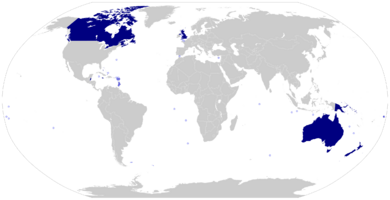
Charles III is the reigning sovereign of each of the 15 Commonwealth realms.
The Realm of New Zealand is one of the Commonwealth realms. These are 15 independent countries in the Commonwealth of Nations that share the same King or Queen as their head of state. They also share the same royal family line of succession. The monarch, King Charles III, lives in the United Kingdom. However, he and his family have visited New Zealand many times.
This system developed over the 20th century. After the Statute of Westminster 1931 was passed in 1931, the Crown became both shared and separate. This means the King's role as monarch of New Zealand is different from his role as monarch of the United Kingdom. So, the monarchy is no longer just a British institution. It has become a separate part of New Zealand. Even so, for historical reasons, the monarchy is sometimes called "British" in everyday language. This is different from the New Zealand government's view of a distinct New Zealand Crown.
When it comes to New Zealand, the King only takes advice from New Zealand ministers. He does not get advice from British or other countries' ministers. One important duty done on the advice of the New Zealand Prime Minister is appointing the Governor-General. Since the King lives outside New Zealand, the Governor-General acts for him. They perform most of his duties in New Zealand, following the Letters Patent 1983. Both the King and the Governor-General can carry out royal powers in New Zealand. In New Zealand law, their roles are interchangeable. As of 2025, the current Governor-General is Dame Cindy Kiro.
The King's Title
Before 1953, the King or Queen had the same title in all their countries. In December 1952, it was agreed that each Commonwealth realm, including New Zealand, could have its own royal titles. The New Zealand Parliament passed the Royal Style and Titles Act in 1953. This changed Queen Elizabeth II's title to Elizabeth the Second, by the Grace of God of the United Kingdom, New Zealand and Her Other Realms and Territories Queen, Head of the Commonwealth, Defender of the Faith.
Later, with the Royal Titles Act 1974, Elizabeth's title in New Zealand became Elizabeth the Second, By the Grace of God Queen of New Zealand and of Her Other Realms and Territories, Head of the Commonwealth, Defender of the Faith. When Charles became King, his title was proclaimed as King Charles the Third, By the Grace of God King of New Zealand and of His Other Realms and Territories, Head of the Commonwealth, Defender of the Faith. This title will be confirmed in a new law.
Even though the King's New Zealand title includes 'Defender of the Faith', neither the King nor the Governor-General has a religious role in New Zealand. New Zealand has never had an official church. This is different from the King's role in England, where the monarch is the head of the Church of England.
Who Becomes King or Queen?

The King's elder son, William, Prince of Wales, is next in line to the throne. For people born before 28 October 2011, the oldest son inherits the throne before older daughters. For those born after 28 October 2011, the oldest child inherits the throne, no matter if they are a boy or a girl.
Laws like the Act of Settlement 1701 and Bill of Rights 1689 say that only direct, legal descendants of Sophia of Hanover can be monarch. Also, the monarch cannot be a Roman Catholic and must be a member of the Church of England. New Zealand can change its own succession rules. However, it has agreed not to do so without all the other Commonwealth realms agreeing. This is like a treaty between these nations. In 2011, the Commonwealth realms made the Perth Agreement. This agreement changed the rules so that male heirs no longer have priority. It also allowed a person married to a Roman Catholic to be in line for the throne. New Zealand made these changes with the Royal Succession Act 2013.

When a monarch dies or steps down, their heir immediately becomes the new King or Queen. There is no need for a special ceremony for this to happen. This is why people say, "The King is dead. Long live the King!" However, it is traditional for the new monarch's arrival to be publicly announced. This happens at a ceremony with the Governor-General and other important officials. After a period of national mourning, the monarch is also crowned in the United Kingdom. This ancient ceremony is not needed for them to rule. All royal powers and duties automatically transfer to the new monarch. All laws and offices remain the same. Any mention of previous monarchs in laws still refers to the current King or Queen of New Zealand. Monarchs rule until they die. They can only step down with permission from the New Zealand government.
Laws called Regency Acts allow for someone to rule if the monarch is too young or unable to rule due to health. If a regency is needed, the next person in line to the throne automatically becomes regent. The Regency Act 1937 is a British law. However, New Zealand's Constitution Act 1986 says that if a regent is appointed in the United Kingdom, that person will also carry out the duties of the King or Queen of New Zealand.
How the Monarchy is Paid For
The King receives money from New Zealand funds to help with his duties when he is in New Zealand or acting as King of New Zealand abroad. New Zealanders do not pay any money to the King or other royal family members for their personal income. They also do not pay to support royal homes outside New Zealand. Usually, tax money only covers the costs of the Governor-General. This includes travel, security, homes, offices, and ceremonies.
Supporters of the monarchy say it costs New Zealand taxpayers very little. This includes royal visits and the Governor-General's expenses. Monarchy New Zealand says this amount is "about one dollar per person per year," which is about $4.3 million each year. A group called New Zealand Republic (who want New Zealand to become a republic) said in 2010 that the Governor-General's office cost about $7.6 million. They also claimed $11 million for upgrades to Government House. Monarchy New Zealand said these figures were "arbitrarily inflated."
Cook Islands, Niue and Other Areas
The King of New Zealand is also the monarch for the Cook Islands and Niue. These are territories that are in free association with New Zealand. The New Zealand monarchy is the same across all parts of the realm. The King is the head of state for all of them equally. This means that the Cook Islands and Niue get their sovereignty from the Crown itself. This happens as part of how the government, laws, and courts work in all three areas.
The Cook Islands have their own self-government. The King is directly represented as head of state in the Cook Islands by the King's representative. The Governor-General of New Zealand represents the monarch for matters that affect the whole realm. In Niue, the Governor-General (represented by the state services commissioner) acts for the monarch. They carry out all the monarch's duties there. The Administrator of Tokelau is a government official. They are appointed by New Zealand's Minister of Foreign Affairs to represent the New Zealand Government, not the monarch personally.
The King as the State
The King is seen as the living symbol of the Crown. He is considered the personification, or legal face, of the New Zealand state. So, the state is often called His Majesty The King in Right of New Zealand, or The Crown (Māori: Te Karauna). This means the King is the employer of all government staff. This includes judges, members of the Defence Force, police officers, and parliamentarians. He also owns all state land and buildings (Crown property), state-owned companies (Crown entities), and the copyright for all government publications (Crown copyright).
I, [specify], swear that I will be faithful and bear true allegiance to Her [or His] Majesty [specify the name of the reigning Sovereign], Her [or His] heirs and successors, according to law. So help me God.
Because the King represents the state, many people who work for the government must swear an oath of loyalty to him. New citizens also take this oath, as stated in the Citizenship Act. This is a promise back to the King, who makes his own Coronation oath. At the coronation of Charles III, he promised to "govern the Peoples of" his realms, including New Zealand, "according to their respective laws and customs."
The King's Role in Government
New Zealand's constitution is made up of many laws and traditions. These come from both Britain and New Zealand. Together, they create a parliamentary system of government where the King has both a legal and practical role. The Crown is seen as a single legal body. The King, as head of state, is at the center of a system where power is shared by different government groups. These groups act under the King's authority.
The many powers that belong to the Crown are called the royal prerogative. These powers do not need parliament's approval. However, they are not unlimited. For example, the King cannot create new taxes without parliament's approval. Parliament must get the Crown's permission before discussing any law that affects the King's powers or interests. No law passed by parliament affects the King or his rights unless the law clearly states it does.
The Executive Branch
The New Zealand Government, also called His Majesty's Government, is defined by the Constitution Act. It is the King acting on the advice of the Executive Council. One of the main jobs of the Crown is to make sure there is always a democratic government. This involves appointing a prime minister. The prime minister then leads the Cabinet, which is a group of ministers who advise the Crown. They must keep the Governor-General informed about state matters.
In a constitutional monarchy with responsible government, the ministers' advice is usually followed. This is often described as "The [King] reigns, but the government rules, as long as it has the support of the House of Representatives." The royal powers belong to the Crown, not to any minister. The King or Governor-General can use these powers on their own in special situations, like a constitutional crisis. This helps ensure the government follows the constitution. There are also a few duties that only the King can do. These include signing papers for Governor-General appointments and approving changes to his New Zealand title.
Foreign Affairs
The King's powers also extend to foreign affairs. The Governor-General handles treaties, alliances, and international agreements. They do this on the advice of the Cabinet. Before 1975, the monarch would sign treaties for New Zealand. After that, it was decided the Governor-General could sign these documents. The Governor-General also appoints New Zealand's high commissioners and ambassadors to other countries. They also welcome diplomats from foreign countries. Passports are issued in the King's name and belong to him.
Parliament's Role
The King is one of the two parts of the New Zealand Parliament. The monarch and Governor-General do not take part in making laws. However, they must give royal assent for a bill to become law. Either the King, the Governor-General, or someone they choose can do this. The Crown is also responsible for calling and ending parliament. After parliament is ended, the Governor-General usually calls for a general election. A new parliamentary session begins with the monarch or Governor-General reading the speech from the throne. Since they are not allowed in the House of Representatives, this ceremony happens in the Legislative Council Chamber. Queen Elizabeth II personally opened parliament seven times.
Even though the King is not in parliament, Members of Parliament must still show their loyalty to him. All new parliamentarians must say an oath of loyalty before they can take their seat. Also, the official opposition is called His Majesty's Loyal Opposition. This shows that even though they are against the current government, they are still loyal to the King as the symbol of the state.
The Courts
The King is responsible for making sure justice is served for everyone. He is traditionally seen as the fount of justice, meaning the source of all justice. He does not personally decide court cases. Instead, judges and justices of the peace carry out these duties in the King's name. The monarch cannot be charged with a crime. The idea is that the King "can do no wrong." The King, and by extension the Governor-General, can also grant protection from being charged. They can also use the royal prerogative of mercy to pardon crimes against the Crown, either before, during, or after a trial.
The Monarchy's Cultural Role
Royal Visits and Duties
Members of the royal family have visited New Zealand since the late 1800s. They come for military events or official royal tours. Important events, anniversaries, or celebrations of New Zealand culture often bring the monarch to New Zealand. Other royals might attend smaller events. Official duties involve the King representing New Zealand at home or abroad. Other royal family members might take part in government ceremonies in New Zealand or overseas. The Prime Minister of New Zealand invites the royals to New Zealand events. A committee in the British Cabinet Office then plans the visit details with New Zealand officials. These events have included anniversaries, Waitangi Day celebrations, and the opening of Commonwealth Games. Unofficial duties are done by royal family members for New Zealand groups they support. This includes attending charity events or visiting the New Zealand Defence Force.

Since 1869, when Prince Alfred visited, many royal tours have happened. Queen Elizabeth II was the first reigning monarch of New Zealand to tour the country. She arrived during her 1953–1954 world tour. She even broadcast her annual royal Christmas message from Government House in Auckland.
Queen Elizabeth II visited New Zealand many other times. In 1963, she attended celebrations at Waitangi. In 1970, she and Prince Charles and Princess Anne took part in James Cook bicentenary celebrations. In 1974, she attended the Commonwealth Games in Christchurch. She also took part in New Zealand Day events. She visited for her Silver Jubilee in 1977 and again in 1981. In 1986, she marked the 100th anniversary of the New Zealand Police. In 1990, she closed the Commonwealth Games in Auckland. She also took part in events marking 150 years since the Treaty of Waitangi. In 1995, she attended a meeting in Auckland and opened the newly renovated parliament buildings. Her last visit was in 2002 for her Golden Jubilee.
Other royals have also made important visits. In 1990, Princess Anne visited for the 75th anniversary of the Gallipoli landings. In 2005, Prince William represented the Queen at war commemorations. He also opened the new Supreme Court of New Zealand building in 2010. Prince Edward spent time as a teacher at the Wanganui Collegiate School in 1982.
I want to show you that the Crown is not merely an abstract symbol of our unity but a personal and living bond between you and me.
The King and his family also do public duties in the other 14 Commonwealth realms. Sometimes, Queen Elizabeth II represented the United Kingdom while her Governor-General represented New Zealand at the same event.
The Crown and the Defence Force
The Crown is at the very top of the New Zealand Defence Force. The Governor-General is the commander-in-chief. Under the Defence Act 1990, they are allowed to "raise and maintain armed forces." These forces include the Royal New Zealand Navy, New Zealand Army, and Royal New Zealand Air Force. The King's role as head of the armed forces is shown in New Zealand's naval ships. They are called His Majesty's New Zealand Ship (or Her Majesty's New Zealand Ship for a Queen). All members of the armed forces must swear loyalty to the King and his heirs. The Governor-General appoints officers to lead the forces.
Allegiance [by Defence Force personnel is to] the Sovereign, [however] loyalty [is] to the Government of the day ... The Defence Force and the disposition of those Forces are at the decision ... of Her Majesty's Ministers for the time being.
The King and his family members also act as colonels-in-chief for different military groups. These roles are mostly ceremonial. They show the Crown's connection with the military. The country's only currently ranked admiral of the fleet, field marshal, and marshal of the air force is King Charles III. Many military groups also have the word royal in their name. Examples include the Corps of Royal New Zealand Engineers and the Royal New Zealand Infantry Regiment.
The Crown and Māori People
Māori first interacted with the Crown in 1832. That's when King William IV appointed James Busby as the British resident. On 28 October 1835, Busby helped organize a meeting at Waitangi. There, a flag was chosen for New Zealand. A declaration of independence written by Busby was signed by 36 Māori chiefs. The King recognized both of these the next year.
Because the British Parliament approved the declaration in 1836, officials decided in 1839 that a treaty needed to be signed with Māori. This was so the British Crown could gain control over New Zealand. The Treaty of Waitangi was signed in 1840 by British representatives and over 500 Māori chiefs. It is seen as a founding document of New Zealand's government. The Treaty talks about the Crown's right to kāwanatanga, or "governorship." One Māori expert says that kāwanatanga, or His Majesty's Government in New Zealand, is a party to the treaty.
Since the treaty was put in place, Māori have sent many requests directly to the King or Queen in London. They felt they had a special connection with the monarch. All these requests were sent back to the monarch's New Zealand ministers for advice. The results were not always good for Māori. They have shown their unhappiness to the monarch or other royals. For example, in 1981, Māori activist Dun Mihaka showed his disapproval to the Prince and Princess of Wales. This was after a request by Mana Motuhake to speak directly to the Queen was denied.
In the Māori language, Queen Elizabeth II was sometimes called te kōtuku-rerenga-tahi. This means "the white heron of a single flight." In Māori sayings, the rare white heron is a special bird seen only once in a lifetime. In 1953, for her coronation, Elizabeth was given a kiwi feather korowai cloak. She wore it when she attended a pōwhiri, or Māori welcoming ceremony. She also spoke partly in Māori.
Royal Symbols
References to the monarchy are common in New Zealand's public life. They are one of the most visible ways the head of state is part of New Zealand's national identity. Royal symbols can show institutions that get their power from the Crown, groups with royal connections, or simply show loyalty.
The main symbol of the monarchy is the King or Queen. As of 2025, Queen Elizabeth II is still shown on all coins, the twenty-dollar banknote, and postage stamps. The St Edward's Crown is on New Zealand's coat of arms and on various medals and awards. These show the monarch's place as the formal head of the New Zealand royal honours system. Only the King can approve the creation of an honour, which he does on the advice of the prime minister. The Governor-General handles most other duties related to New Zealand honours for the King.

Flags are also used to represent royal authority. A personal flag for the Queen to use in New Zealand was adopted in 1962. It shows the shield design from the New Zealand coat of arms. In the middle is a dark blue circle with an 'E' and a crown, surrounded by gold roses. King Charles III has not yet adopted a personal flag for New Zealand.
Music and songs remind people of the King or Queen. New Zealand inherited the anthem "God Save the King" (or "God Save the Queen") from Britain. It is still one of New Zealand's two national anthems, along with "God Defend New Zealand". "God Save the King" is mostly used for official events when the monarch, a royal family member, or the Governor-General is present. The King has the right to declare a song a national anthem.
Like in other Commonwealth realms, the King's Birthday is a public holiday in New Zealand. It is celebrated on the first Monday in June, not on the King's actual birthday. Celebrations are mainly official, including the Birthday Honours list and military ceremonies.

Groups with Royal Support
To receive patronage, a group must show it has been around for a long time and is excellent in its field. These groups, like the Royal New Zealand Returned and Services' Association, have the word royal in their name. They have received support from different monarchs and their families. It is the royal individual's choice to give patronage. The Ministry for Culture and Heritage helps groups seek this support.
Debate About the Monarchy
Even though the monarchy is involved in New Zealand and Australia in similar ways, there is less talk in New Zealand about becoming a republic. In Australia, the movement to become a republic is stronger. Past public polls have shown that most Australians want a republic. However, New Zealanders generally prefer to keep the monarchy. Supporters of the monarchy say that for New Zealand, "monarchy summarises the inheritance of a thousand years of constitutional government and our links with a glorious past."

Neither the National nor Labour parties, the two main political parties in parliament, have a policy to create a republic. The National Party's principles include "Loyalty to ... our Sovereign as Head of State." In 2008, former Prime Minister John Key said he was "not convinced [a republic] will be a big issue in the short term." But he did believe a republic was "inevitable." Former Deputy Prime Minister Michael Cullen supported the monarchy in 2004. In 2010, he changed his mind. He then thought New Zealand should become a republic after the Queen's reign ended. There are two groups that argue about this in the media: Monarchy New Zealand (who support the monarchy) and New Zealand Republic (who want a republic).
There are several legal issues to deal with if the monarchy were to be abolished. People on both sides of the argument have different ideas about how difficult this would be. Much of the debate focuses on the King's special powers. It also looks at the relationship between the different parts of the Realm of New Zealand that share the same King. Another key point is how it would affect the relationship between the Crown and Māori people. This includes the legal status of the Treaty of Waitangi and its claims. Some experts worry that governments could use republicanism to avoid treaty responsibilities. Others, like Professor Noel Cox, have argued a republic would not remove the Government's duties under the treaty.

Most New Zealanders support the monarchy, especially those born before World War II. Queen Elizabeth II was very popular. The Treaty of Waitangi's place under a republic is still a concern for Māori and other New Zealanders. Also, the exact form a republic might take is not clear. Because of these reasons, support for a republic has not been higher than 33% to 40% of the population. Polls show that many New Zealanders feel the monarchy is not very important in their daily lives. A 2002 poll found that 58% of people thought the monarchy had little or no relevance. A 2004 poll found 57% believed New Zealand would become a republic "in the future." In January 2010, a poll found 33.3% wanted Prince Charles to be the next monarch. 30.2% preferred Prince William, and 29.4% wanted a republic if Queen Elizabeth died or stepped down.
On 14 October 2009, a bill by Keith Locke to hold a public vote on the monarchy was introduced in parliament. On 21 April 2010, the bill was defeated by a vote of 68–53.
Before a royal tour by Prince Charles and Camilla in November 2012, a poll found 70% of people wanted to "keep The Queen as head of state." Only 19% supported a republic. After the tour, a poll found 51% wanted Charles as King once the Queen's reign ended, while 41% supported a republic.
After the death of Queen Elizabeth II in September 2022, a poll showed that support for a republic decreased. 50% of people preferred to stay with the monarchy.
Support for the monarchy in New Zealand often goes up when there is a lot of attention on the royal family. This happens during royal tours or big events like a royal wedding.
History of the Monarchy in New Zealand
In the early 1800s, some Māori who visited London met British royalty. Moehanga, the first Māori to visit England, said he met King George III and Queen Charlotte in 1806. Other chiefs, like Hongi Hika, met King George IV in 1820.
Lieutenant James Cook first sailed to New Zealand in 1769. He mapped the coastline and claimed the land for King George III. From 1790, more European settlers came to New Zealand. By 1833, there was growing lawlessness among traders and settlers. The British government appointed James Busby as British resident to protect British trade. But problems continued, so more action was needed. On 15 June 1839, the governor of the British colony of New South Wales, Sir George Gipps, announced that New South Wales' borders would include any territory in New Zealand that Britain gained control of. The British government sent Captain William Hobson to New Zealand to be lieutenant-governor under Gipps. Hobson was told to gain control for the British Crown with the agreement of Māori chiefs. The Treaty of Waitangi was signed on 6 February 1840, at Waitangi. This led to the official announcement of British rule over New Zealand on 21 May 1840. After that, Britain decided to make New Zealand a separate colony. A Charter for Erecting the Colony of New Zealand was issued on 16 November 1840. Queen Victoria then became New Zealand's head of state.
In 1852, the New Zealand Constitution Act 1852 was passed. This law created responsible government in New Zealand. It also allowed the governor to give the Royal Assent on behalf of the King or Queen.
Queen Victoria's second son, Prince Alfred, was the first British royal to visit New Zealand. He arrived in Wellington on 11 April 1869.
In 1907, New Zealand became a dominion. This meant it was a country in the British Empire (and later the Commonwealth of Nations) that could make its own decisions about its own affairs and foreign policy. In 1917, King George V issued official documents that set out the powers and duties of the Governor-General and the Executive Council. The Governor-General was still appointed by the British Crown on the advice of the British government.

The idea of a fully independent New Zealand, sharing the same King or Queen with the United Kingdom and other countries, grew slowly over time. Several Imperial Conferences were held in London starting in 1917. These led to the Balfour Declaration of 1926. This declaration stated that the United Kingdom and the dominions were "autonomous communities within the British Empire, equal in status." They were "in no way subordinate to one another" but were "united by a common allegiance to the Crown." The Governor-General of New Zealand, like other Governors-General in the Dominions, became the direct representative of the monarch. They were no longer just a link between the New Zealand and British governments.
The Crown became even more separate among its dominions with the Statute of Westminster 1931. This British law allowed New Zealand and other dominions to make their own laws. It also required them to agree with each other on changes to royal titles and the line of succession. The British Parliament gave up its right to make laws for a dominion, unless the dominion asked for it. New Zealand approved this Statute in 1947.
Even though the New Zealand monarchy is now independent, it still has strong ties to the British monarchy and its history. For example, many portraits of earlier English kings and queens (before 1840) are in New Zealand government buildings.
I look forward to continuing to serve to the best of my ability in the years to come. It fills me with great pride to stand before you here today to express my lasting respect and deep affection for this country and for New Zealanders everywhere.
One of the first examples of New Zealand's independent monarchy after World War II was the change to the monarch's title in 1953. For the first time, the official New Zealand title mentioned New Zealand separately from the United Kingdom. This showed the King or Queen's role specifically as monarch of New Zealand. Elizabeth II's title at that time was Queen of the United Kingdom, New Zealand and Her Other Realms and Territories. The country's official name also changed to the Realm of New Zealand. The Royal Titles Act 1974 further changed the monarch's New Zealand title to remove the reference to the United Kingdom.
More recently, the Constitution Act 1986 became the main formal statement of New Zealand's constitution. This law officially states that the King or Queen (in Right of New Zealand) is the head of state of New Zealand. It also says that the Governor-General is their representative. Each can generally use all the powers of the other.
List of Monarchs
Here are the seven monarchs who have ruled over New Zealand. This includes the British colony of New Zealand from 1840, then the Dominion of New Zealand starting in 1907, and finally the present-day sovereign state of New Zealand. At first, these monarchs ruled as British sovereigns.
| Portrait | Regnal name Te reo (Birth–Death) |
Reign | Full name | Consort | House | |
|---|---|---|---|---|---|---|
| Start | End | |||||
 |
Victoria Wikitōria (1819–1901) |
21 May 1840 | 22 January 1901 | Alexandrina Victoria | Albert of Saxe-Coburg and Gotha | Hanover |
| Governors: William Hobson, Robert FitzRoy, Sir George Grey, Thomas Gore Browne, Sir George Ferguson Bowen, Sir George Ferguson Bowen, Marquess of Normanby, Sir Hercules Robinson, Sir Arthur Hamilton-Gordon, Sir William Jervois, Earl of Onslow, Earl of Glasgow, Earl of Ranfurly | ||||||
| Premiers/Prime ministers: Henry Sewell, Sir William Fox, Sir Edward Stafford, Alfred Domett, Sir Frederick Whitaker, Sir Frederick Weld, George Waterhouse, Sir Julius Vogel, Daniel Pollen, Sir Harry Atkinson, Sir George Grey, Sir John Hall, Sir Robert Stout, John Ballance, Richard Seddon | ||||||
 |
Edward VII Eruera te Tuawhitu (1841–1910) |
22 January 1901 | 6 May 1910 | Albert Edward | Alexandra of Denmark | Saxe-Coburg and Gotha |
| Governors: Earl of Ranfurly, Lord Plunket | ||||||
| Prime ministers: Richard Seddon, Sir William Hall-Jones, Sir Joseph Ward | ||||||
 |
George V Hōri te Tuarima (1865–1936) |
6 May 1910 | 20 January 1936 | George Frederick Ernest Albert | Mary of Teck | Windsor |
| Governors/Governors-general: Lord Plunket, Lord Islington, Earl of Liverpool, Viscount Jellicoe, Sir Charles Fergusson, Lord Bledisloe, Viscount Galway | ||||||
| Prime ministers: Sir Joseph Ward, Sir Thomas Mackenzie, William Massey, Sir Francis Bell, Gordon Coates, George Forbes, Michael Joseph Savage | ||||||
 |
Edward VIII Eruera te Tuawaru (1894–1972) |
20 January 1936 | 11 December 1936 | Edward Albert Christian George Andrew Patrick David | None | Windsor |
| Governor-general: Viscount Galway | ||||||
| Prime minister: Michael Joseph Savage | ||||||
 |
George VI Hōri te Tuaono (1895–1952) |
11 December 1936 | 6 February 1952 | Albert Frederick Arthur George | Elizabeth Bowes-Lyon | Windsor |
| Governors-general: Viscount Galway, Sir Cyril Newall, Lord Freyberg | ||||||
| Prime ministers: Michael Joseph Savage, Peter Fraser, Sir Sidney Holland | ||||||
 |
Elizabeth II Irihāpeti te Tuarua (1926–2022) |
6 February 1952 | 8 September 2022 | Elizabeth Alexandra Mary | Philip Mountbatten | Windsor |
| Governors-general: Lord Freyberg, Sir Willoughby Norrie, Viscount Cobham, Sir Bernard Fergusson, Sir Arthur Porritt, Sir Denis Blundell, Sir Keith Holyoake, Sir David Beattie, Sir Paul Reeves, Dame Catherine Tizard, Sir Michael Boys, Dame Silvia Cartwright, Sir Anand Satyanand, Sir Jerry Mateparae, Dame Patsy Reddy, Dame Cindy Kiro | ||||||
| Prime ministers: Sir Sidney Holland, Sir Keith Holyoake, Sir Walter Nash, Sir Jack Marshall, Norman Kirk, Sir Bill Rowling, Sir Robert Muldoon, David Lange, Sir Geoffrey Palmer, Mike Moore, Jim Bolger, Dame Jenny Shipley, Helen Clark, Sir John Key, Sir Bill English, Dame Jacinda Ardern | ||||||
 |
Charles III Tiāre te Tuatoru (born 1948) |
8 September 2022 | present | Charles Philip Arthur George | Camilla Shand | Windsor |
| Governors-general: Dame Cindy Kiro | ||||||
| Prime ministers: Dame Jacinda Ardern, Chris Hipkins, Christopher Luxon | ||||||
Timeline of Kings and Queens

See also
- Māori King Movement
- Monarchy in the Cook Islands
- List of Niuean monarchs
- Monarchies in Oceania
- List of monarchies
- Royal Train (New Zealand)


